The sketchbook. Teeny weeny.
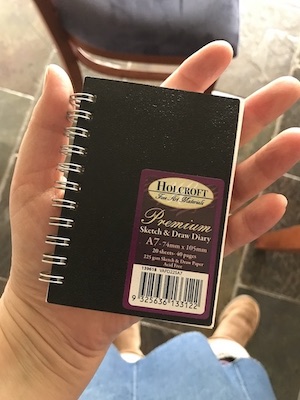
For the first flower, I went out into the garden looking for something relatively simple to start with. And accessible. Most of our flowering plants are on a steep embankment, but I found this little nasturtium had sprouted behind a low retaining wall where most of my lavenders died.

I learned two things from this: first to consider carefully if the picture needed a background, second that sometimes you can’t mix a colour and need to add a new pigment to your set. In this case, I brought out the Stuart Semple palette, which had an orange bright enough for the flower. From then on it was my first choice when I wanted to use paint.
Next, the red hot poker had one last flower on it, so I decided to do that before the opportunity passed.
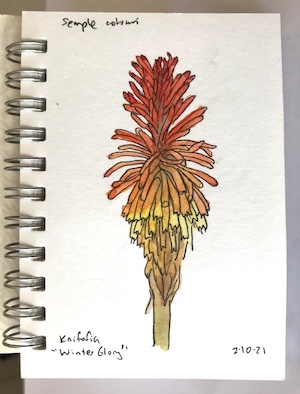
Much happier with this one. I realised that at eye level the tubular flowers rarely come straight at me, but up and down.
Next, I was going to paint bright yellow flowers on one of the natives, but they were already past their prime and their position on the embankment was not going to make for comfortable painting. Instead, I headed for the Unexpected Succulent Garden, which has been looking amazing recently.
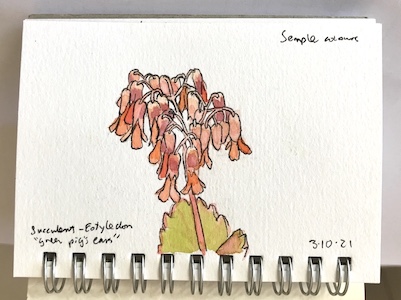
I hadn’t intended to add the leaves, but got inspired. But adding them put the picture off balance on the page.
Soon after I started the next one, I went and got a seat. I thought I’d be able to sit on a rock, but I was wrooooong. I got myself a stool.
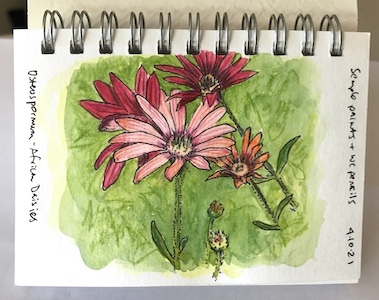
It really needed a green background to contrast with the red flowers. The paints weren’t getting me the feel of the subtly striped petals, so I ducked inside and got some watercolour pencils.
I’d be happier with this if I’d managed to centre the flowers on the page. I had to look up the name of the succulent and this one, and I was amused to find this one was an African Daisy. A couple of years ago I went looking for African Daisies for the front garden, not realising I already had them in the kitchen garden.
The next day was really cold, so I turned to my iPhone’s photo albums. And I finally managed to get a flower centred.
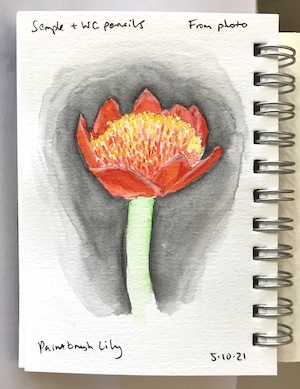
Again, watercolour pencils made adding texture much easier.
This plant isn’t in flower at the moment. It’s in the giant tongue-like leaves stage. They’ll die off and the plant will all but disappear until the flowers emerge from the ground next autumn, first with bright buds like giant parrot beaks, then opening to make these alien-like flowers.
The following day was lovely for flower painting.

The label stuck into my gardening diary told me this was a Dianthus. It didn’t mention that Dianthus are ‘pinks’, which it turns out is another name for carnations. Now I understand why on gardening shows presenters would sometimes gesture to a bed of not-pink flowers and call them pink.
Turns out the colour pink is named after the flowers, not the other way around. And pinking shears are named after the shape of the petal ends.
This one was quite the research black hole.
The seventh flower was a rose. One of my climbers.
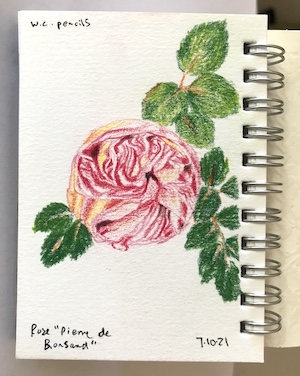
No paint this time, just watercolour pencils without water. It suited the densely packed petals.
Overall, I found that I was always better off trying to painting what I saw, including flaws, rather than ‘fix’ anything or try to ‘just paint the gist of it’. Taking photos and looking at the thumbnails helped to reveal overall flaws too, and a friend’s honest assessment that the carnation looked a bit flat helped me fix the problem.
The painting have taken between 20 mins and an hour and a half. I’m sure I’ll get faster, or at least better at choosing quick subjects when I’m short on time. Though it is nice to spend more time as well when I have it.
